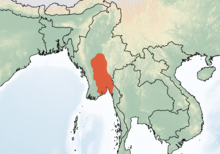| Popa langur | |
|---|---|
| Scientific classification | |
| Domain: | Eukaryota |
| Kingdom: | Animalia |
| Phylum: | Chordata |
| Class: | Mammalia |
| Order: | Primates |
| Suborder: | Haplorhini |
| Infraorder: | Simiiformes |
| Family: | Cercopithecidae |
| Genus: | Trachypithecus |
| Species: | T. popa
|
| Binomial name | |
| Trachypithecus popa Roos et al., 2020
| |

| |
The Popa langur (Trachypithecus popa) is a species of primate in the family Cercopithecidae. It occurs only in Myanmar and was named after Mount Popa, where a population of 100 of the monkeys live.[2] It is listed as Critically Endangered on the IUCN Red List, as the wild population is thought to comprise 200 to 250 mature individuals.[1]
YouTube Encyclopedic
-
1/1Views:1 794
-
NEW ANIMALS??? STEGOSAURUS, PAINTED WOLF, PLATYPUS, POPA LANGUR
Transcription
Taxonomy
The Popa langur was discovered in 2020 in a lab setting instead of the field. A phylogenetic study was conducted with the effort of understanding the Popa langur's taxonomic relationships with other species of the genus. For this study, scientists used fecal samples from wild langurs and tissue samples from museum specimens.[3]
Alongside the genetic analysis the discovery also involved the comparison of the Popa langur with a specimen of the Phayre's langur at the Natural History Museum, London. The examination revealed small differences in their skins, skulls and coloration.[4]
Characteristics
The Popa langur has a dark-brown or grey-brown back, a white belly, and black hands and feet. It has distinctive white rings around the eyes, as well as the muzzle. It weighs around 8 kg (18 lb).[2]
Distribution and habitat
The Popa langur occurs in central Myanmar, mainly around Mount Popa.[4]
Conservation
The Popa langur is threatened by hunting, habitat destruction and fragmentation.[2][1]
See also
References
- ^ a b c Matauschek, C.; Meyer, D.; Lwin, N.; Ko Lin, A.; Lin, A.; Momberg, F.; Roos, C. (2022). "Trachypithecus popa". IUCN Red List of Threatened Species. 2022: e.T196344474A196344962. doi:10.2305/IUCN.UK.2022-1.RLTS.T196344474A196344962.en. Retrieved 29 July 2022.
- ^ a b c Roos, Christian; Helgen, Kristofer M.; et al. (2020). "Mitogenomic phylogeny of the Asian colobine genus Trachypithecus with special focus on Trachypithecus phayrei (Blyth, 1847) and description of a new species". Zoological Research. 41 (6): 656–669. doi:10.24272/j.issn.2095-8137.2020.254. ISSN 2095-8137. PMC 7671912. PMID 33171548.
- ^ Roos, Christian; Liedigk, Rasmus; Thinh, Van Ngoc; Nadler, Tilo; Zinner, Dietmar (2019). "The hybrid origin of the Indochinese Gray Langur Trachypithecus crepusculus". International Journal of Primatology. 40 (1): 9–27. doi:10.1007/s10764-017-0008-4. S2CID 11460634.
- ^ a b "New species of monkey is already critically endangered". www.nhm.ac.uk. Retrieved 2022-10-28.

